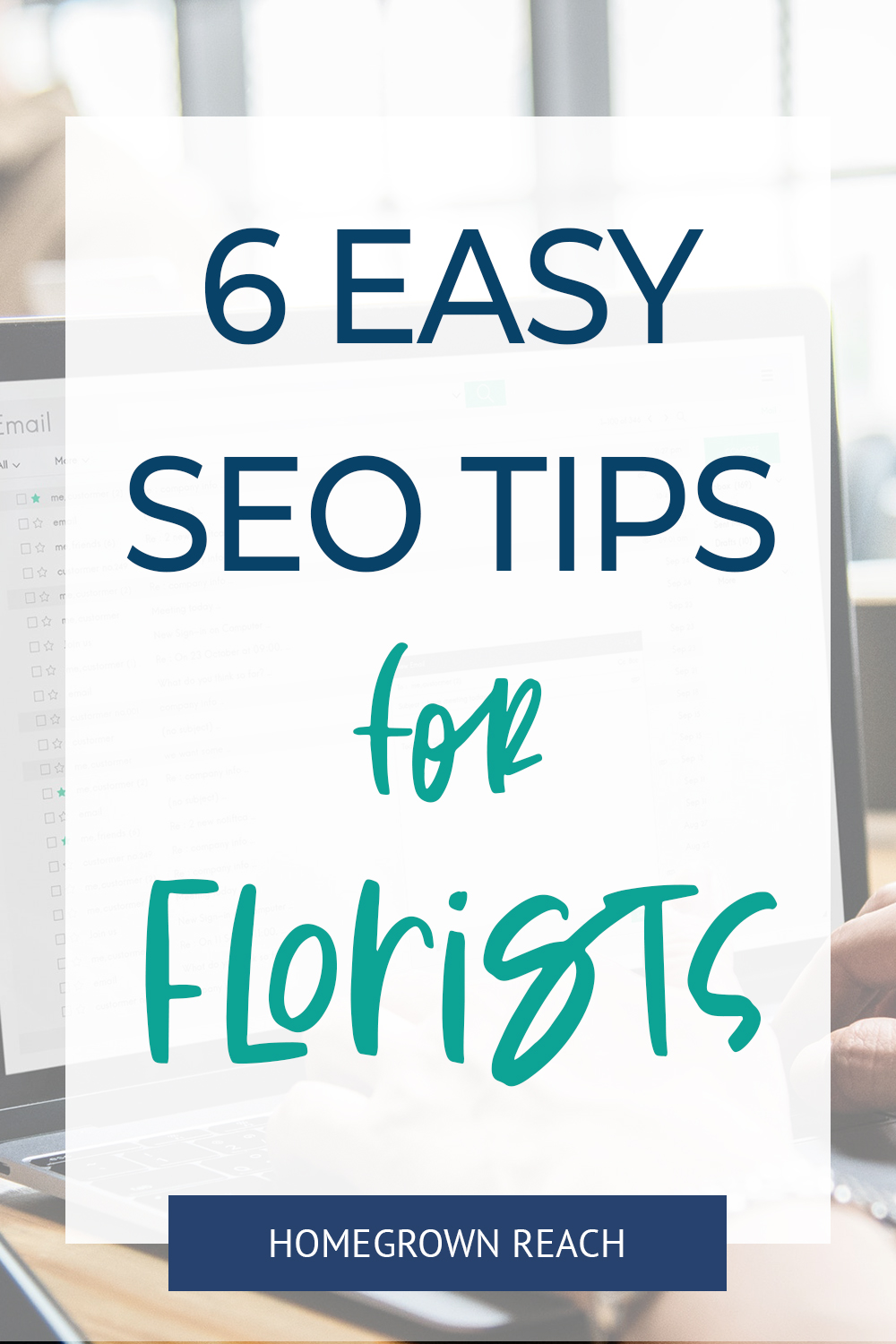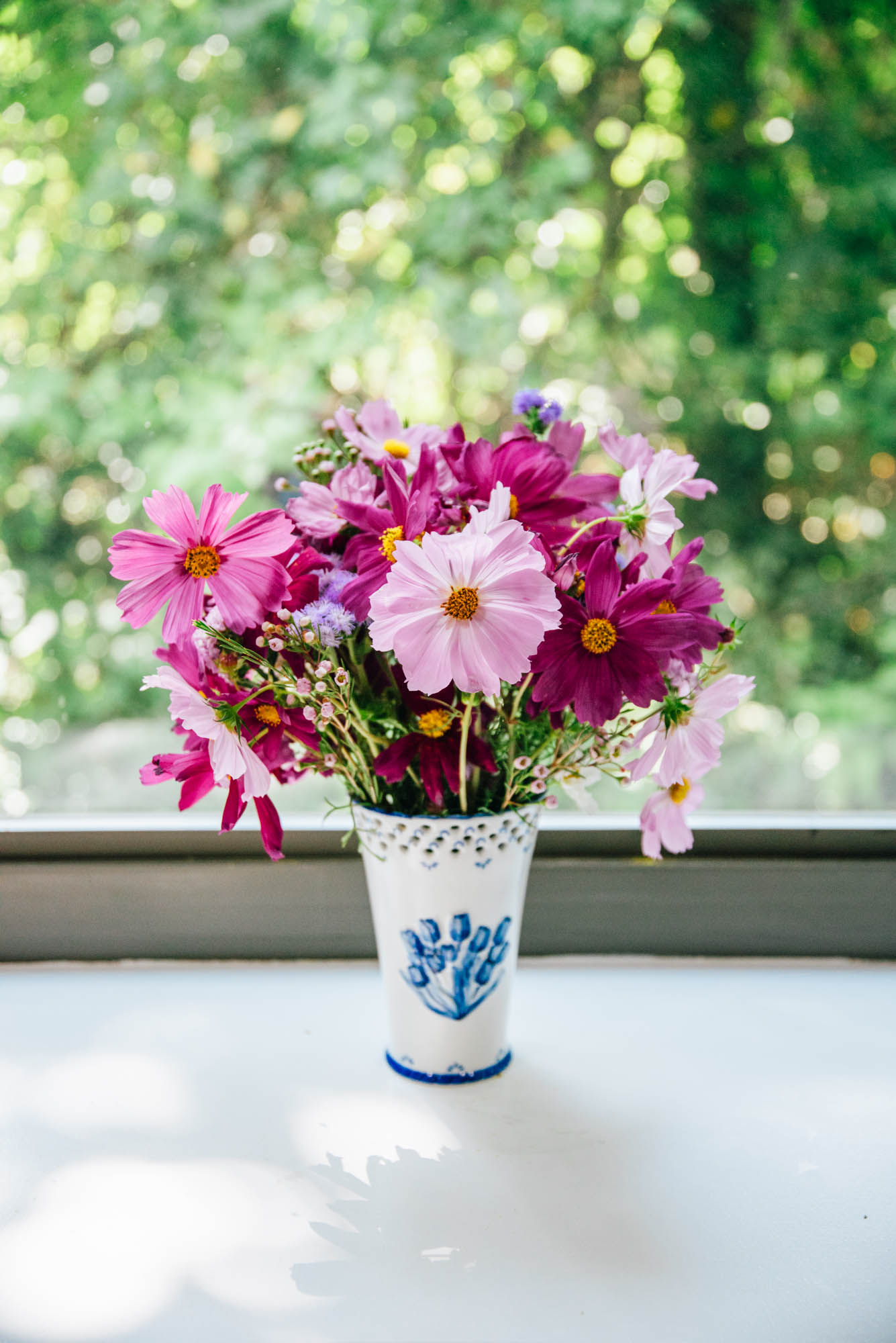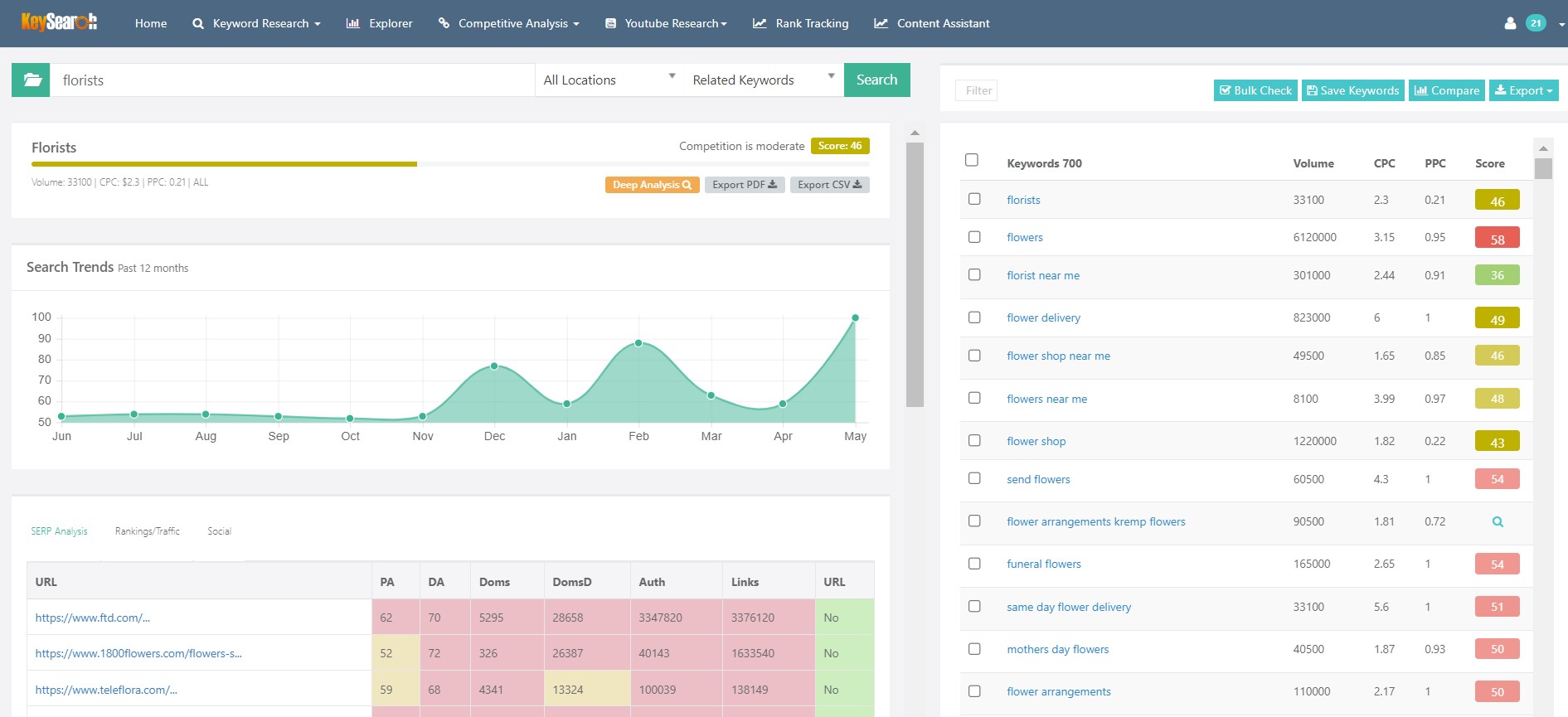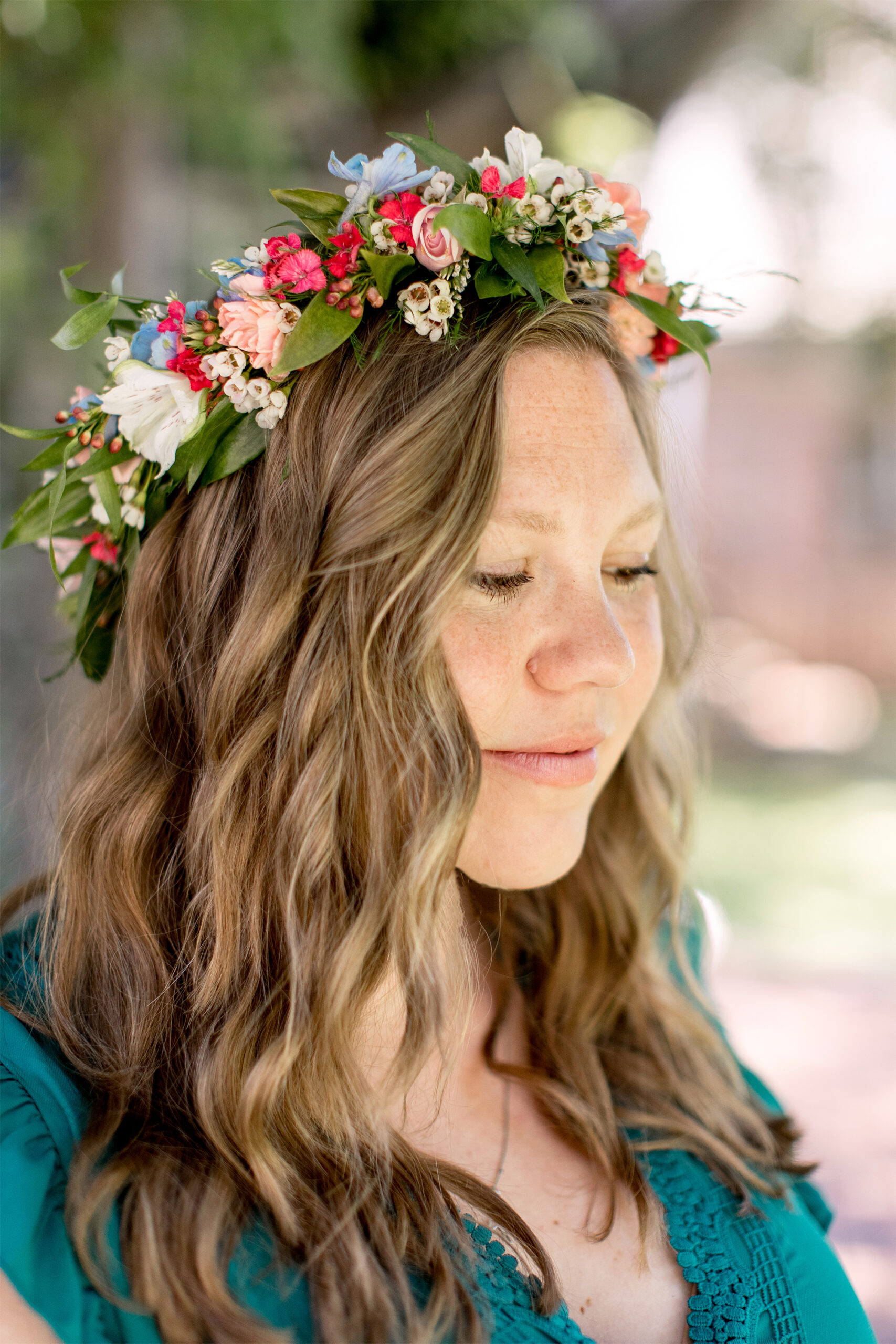Want your florist website to rank higher on Google?
I know SEO sounds daunting, but it doesn’t have to be hard! I have 6 easy tips for SEO for florists that will help you rank higher AND convert more customers. And you can even implement them today!

Understand your audience
Before you should do anything to your website (or even your other marketing efforts), make sure you know who your target customer is and what they’re interested in. Are you trying to focus on weddings? Or do you have a flower farm and you want people to come to you?
If, for example, you’re trying to focus on being a wedding florist, then your content needs to speak to busy brides and grooms who might be stressed out about alllll the different things they need to do to get ready for the wedding. They also might need more help understanding the different floral pieces they need or even what the difference between the bride’s bouquet and a tossing bouquet is.

And if you have a flower farm or want to sell fun bouquets at the farmer’s market, then you probably don’t need to have quite so much informative content. You can focus more on the experience and the feelings that go with it. Talk about how memories are made when parents take their children to pick flowers and even different ways they can preserve those flowers to be able to preserve those memories for the children.
By understanding your target audience, you can connect with them better to help increase conversions (and hopefully have repeat customers). There are many different types of services florists offer, so make sure you know which type of audience you’re trying to reach so you know how to serve them and speak to them best!
Do keyword research
Before you can focus on SEO for your florist site, you need to know what people are searching for. Keyword research tools will show you what people are searching for, as well as the competition level and the monthly search volume. You want to make sure you’re not targeting keywords that are way too competitive or that no one is searching for!
There are lots of free and paid keyword research tools out there. Ubersuggest is my favorite one with a free plan if you’re just getting started, and Keysearch is my favorite paid tool that won’t break the bank. If you don’t know what types of keywords to search for, start with phrases that include your services and your location (if applicable).

So for example, search for something like “florist in Philadelphia.” If the monthly search volume is 0 or if it’s really competitive (keyword research tools are usually color coded and orange/yellow and red competition scores are the most competitive), then you can get more specific with your services or area if you’re in a big city. You could narrow it down to something like “florist in Rittenhouse Square” or “event florist in Philadelphia,” depending on your location and what you offering.
You may need to play around with it before you find some good keywords that you’ll be able to rank for, but keyword research is a key step in SEO to make sure you’re able to rank well in Google.
Use your keywords and write clear copy
Something I see very often is that a business owner knows what they do, but they don’t actually say it! Actually using your keywords is one of the easiest and most impactful of my tips for SEO for florists.
Keywords need to be used in 1-5% of the total copy in order to have a good potential to rank for them, so make sure you’re actually using your keywords throughout your copy and don’t just say you’re a florist in Philadelphia in the footer.
So if you’re a florist, make sure you’re explicitly clear and say you’re a florist. You can add more flowery language (pun intended) after you’re crystal clear on what you do.
If the first thing you say is “I create beautiful designs for couples on their special day,” it could mean a lot of different things. But if you say “As a florist in [list your location], I create beautiful designs for couples on their special day,” it’s much more clear to both potential customers and to Google what you do.
This is more of a conversion tip than an SEO tip for florists, but I also recommend having information about your services on your website (even if you don’t list pricing because it can be so custom). If someone has something specific they’re looking for, you want to make sure you have it listed so they don’t just move onto another florist.

For example, for a maternity photoshoot I did, I really wanted a flower crown. I visited a ton of websites for florists in my area and none of them had flower crowns listed (and most didn’t even have ANY of their offerings listed), so I had to contact a lot and ask them. It took a lot of time before I found a florist who made flower crowns, and my search would have been so much easier if the websites had listed the services they offer.
So if someone has something specific that they want, like a floral arch for their wedding day, and it’s not listed on your website so they’re not sure if you offer it, you could be missing out on business if they leave and go to another florist’s site.
Write title tags and meta descriptions
Don’t neglect your title tags and meta descriptions! They are so beneficial for your SEO.
Title tags and meta descriptions are the page title and description you see when a page is ranking on Google. A lot of website platforms say they’re “optional” (I’m looking at you Squarespace), but if you don’t fill them in, Google will do it for you. And I’ve seen Google do crazy things like pull the page titles from the menu or titles of images to fill in the meta descriptions, which can look very confusing or unprofessional to potential customers.

Title tags are a ranking factor for Google, so make sure you’re using your keywords here, too. So instead of just using the page title like “About,” you can write “About Julia | Wedding Florist in Philadelphia.” And use the meta description as a quick summary of what’s on the page to speak to your ideal customer and compel them to want to visit the page for more information.
Focus on your user experience
Google is focusing more and more on user experience for ranking metrics, and it can also make or break your customer conversions. You only have a couple of seconds to capture someone’s attention, so if your site is really slow to load or your menu isn’t clear, you could lose potential customers quickly.
So along with being clear on what you do and what your services are, make sure it’s easy for website visitors to navigate your site to find what they’re looking for and contact you. Make sure your site isn’t too slow with tools like PageSpeed Insights or GTMetrix (large photos and videos are usually the main culprits, so size those down and compress them), everything from your font size to the brand colors are accessible (no yellow text on a white background, please!), your site is mobile friendly, and your menu is clear and isn’t cluttered with too many options.

And one big thing I see overlooked is calls-to-action (CTAs). Have clear, eye-catching CTA buttons throughout your site pages and at the end of blog posts to lead people to check out your services or contact you to inquire. It’s a small thing that can make such a big impact!
Stay active on Google Business Profile
If you have a location or serve a local area, Google Business Profile (formerly Google My Business) can help your florist business (and SEO) so much. It gives potential customers a quick overview of your business, your location, and how to contact you.
I recommend updating some things on GBP every month to show Google that your business is active and to help your rankings. Reviews can help your rankings (and customer conversions) a ton, so make sure you’re regularly asking your customers for reviews. You can also add new photos of your work every month to show off new projects. And you can add posts to advertise any events or specials you’re having, or you can use them to write a summary of a blog post and link back to your blog post to help increase traffic.

You don’t need to show up every single day on GBP or write lengthy posts, even just adding a few photos and one or two posts each much can make a difference!
I hope this shows you that SEO for florists doesn’t have to be complicated or confusing! It’s really about focusing on your ideal customer and making things super clear and easy for them to be able to hire you. And the more you focus on these SEO elements for your florist site, the better your customer conversions can be!

If you’re interested in getting your florist website optimized, I offer SEO for florists to help you rank higher on Google, so check out my SEO services and see how I can help 🙂